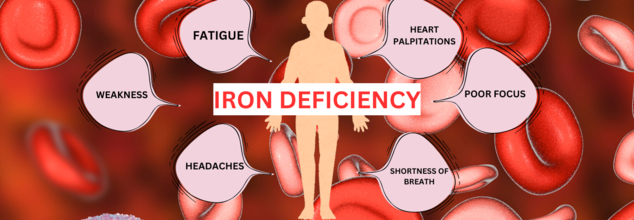- Health Conditions A-Z
- Health & Wellness
- Nutrition
- Fitness
- Health News
- Ayurveda
- Videos
- Medicine A-Z
- Parenting
- Web Stories
Cold Hands And Brittle Nails? Could Be Undiagnosed Sign Of Iron Deficiency

Iron deficiency Symptoms
I remember sitting at my desk one afternoon, struggling to focus on a simple task. My thoughts were clouded, and I felt unusually exhausted, despite having slept well the previous night. I shrugged it off, blaming work stress and a busy schedule. But as the days went on, the fatigue became more pronounced. I realized something deeper might be at play.
After visiting my doctor, the culprit was clear: I had iron deficiency.
Feeling tired, irritable, or having trouble concentrating are all subtle signs that may point to an iron deficiency. According to the World Health Organization (WHO), iron deficiency is the most widespread nutritional disorder globally, affecting people in both developed and developing nations. But, despite its prevalence, many remain unaware they are affected because symptoms often mimic general tiredness or stress.
WHO estimates that over 30% of the global population is anaemic, with many cases stemming from iron deficiency. This condition can worsen, especially in developing countries where infectious diseases can exacerbate iron depletion. Iron deficiency, when left unaddressed, can progress into iron deficiency anaemia, a condition where haemoglobin levels drop significantly.
Haemoglobin is the protein in red blood cells responsible for transporting oxygen from the lungs to the rest of the body. Without enough of it, the body's oxygen supply diminishes, resulting in symptoms like fatigue, weakness, and shortness of breath.
The National Institutes of Health (NIH) explains that iron deficiency can also cause dizziness, headaches, cold extremities, pale skin, and chest pain. In more severe cases, your heart must work harder to circulate oxygen, which can lead to irregular heartbeats and other cardiovascular problems. Beyond physical symptoms, iron deficiency can impact cognitive function, memory, and overall productivity, significantly lowering one's quality of life.
Importance of Iron in the Diet
Iron is vital for the production of red blood cells, which transport oxygen throughout the body. Without adequate iron, the body is at risk of developing anaemia, and people may experience persistent fatigue, weakness, and a range of other symptoms. Yet, many cases of iron deficiency can be managed or even prevented with simple dietary changes.
Iron-rich foods are key to maintaining optimal health. Red meat, particularly darker cuts like beef or lamb, is an excellent source of haem iron, the type of iron most easily absorbed by the body. In contrast, non-haem iron, found in plant-based foods, isn't absorbed as efficiently.
This is why experts recommend combining iron-rich plant foods like spinach, lentils, and fortified cereals with vitamin C-rich foods like citrus fruits, which enhance iron absorption.
One common dietary habit to avoid is consuming tea with meals. The tannins in tea can inhibit iron absorption, so it’s better to enjoy tea between meals.
Pregnant and breastfeeding women, in particular, should ensure they consume two servings of iron-rich foods per day. These servings might include lean red meat, poultry, seafood, eggs, or legumes, as advised by health professionals.
Iron Deficiency in Women: Hidden Impact of Menstruation
A significant factor contributing to iron deficiency in women, especially adolescents, is menstruation. Dr. Angela Weyand, an associate professor at the University of Michigan Medical School, points out in a Mirror report, that menstruation can drastically reduce iron stores in the body.
Young girls, in particular, may struggle with concentration in school due to undiagnosed iron deficiency, impacting their educational performance.
Heavier periods can be an additional challenge, as explained by Dr. Rachel Bercovitz of Northwestern University in a Mirror report. She notes that if a woman is changing her tampon or pad more frequently than every four to six hours, this could indicate heavy menstrual bleeding, which may further deplete iron levels.
In fact, a study conducted by the University of Michigan Medical School found that six percent of young girls aged 12 to 21 had iron-deficiency anaemia. Problems such as 'brain fog' and difficulty concentrating, which many women attribute to general fatigue, could very well be linked to low iron levels. Weyand believes these findings are only the "tip of the iceberg."
How to Check for Iron Deficiency?
Despite its widespread occurrence, iron deficiency often goes undiagnosed. One reason is that routine blood tests commonly screen for anaemia rather than directly measuring ferritin, a protein that stores iron in the blood. Ferritin tests can reveal hidden deficiencies before they become severe. The Centers for Disease Control and Prevention (CDC) recommends women of reproductive age have their iron levels checked at least once a decade.
For those who are deficient, iron supplementation may be necessary but should only be done under medical supervision. Over-the-counter supplements can be risky if not taken correctly, especially during pregnancy or breastfeeding.
Preventing and Managing Iron Deficiency
Preventing iron deficiency doesn’t have to be complicated. Incorporating iron-rich foods into your daily diet is a simple yet effective strategy. The CDC suggests adding the following foods to your meals to boost iron levels:
- Red meat (beef, pork, lamb, or venison)
- Seafood (fatty fish like salmon)
- Poultry (chicken or turkey)
- Eggs
These foods provide "heme" iron, which is more readily absorbed by the body. For those on a plant-based diet, non-heme iron sources such as lentils, beans, and iron-fortified cereals should be consumed with vitamin C-rich foods to increase absorption.
Iron deficiency is more than just a source of fatigue—it can have serious, long-term effects on your health. Being aware of the symptoms and maintaining a balanced diet with iron-rich foods can help keep your energy levels high and prevent complications.
If you suspect an iron deficiency, it's essential to speak to a healthcare provider and get a blood test to check your levels. With the right approach, you can easily restore and maintain healthy iron levels.
Harvard Psychologist Lists Careers Linked To Higher Rates Of Suicide: Doctors Maybe At High Risk Themselves

(Credit- Canva)
Suicides are one of the leading causes of death around the world. While it is easy to say that the person who chose to take their lives did it of their own violation, Harvard psychologist Dr. Matthew Nock, explains the other side. “90% of people who try and kill themselves say, I didn't want to die per se. I wanted to escape from seemingly intolerable.” Speaking on the On Purpose podcast with Jay Shetty, Dr. Nock pointed out that the link between work pressure and suicidal thoughts varies by race and ethnicity.
The concerning rise in suicide cases tied to work pressure has fueled a social media conversation about toxic work culture. What was once considered a normal part of the professional grind is now being openly challenged, as people share personal stories of the anxiety, depression, and isolation caused by unhealthy work environments.
What Professions Are At High Risk Of Suicide?
According to Dr. Matthew Nock, certain careers are linked to a higher risk of suicide.
Police Officers
He noted that physicians and police officers are among those at high risk. He mentioned a spike in suicides among New York City police officers, who are predominantly white men, and shared that female police officers, in particular, face a higher risk, even when accounting for factors like age, race, and ethnicity.
According to a 2025 study published in the Police Practice and Research, on average, 21.4 out of every 100,000 officers died by suicide each year.
The study showed that the suicide rate was much higher for male officers (22.7 per 100,000) than for female officers (12.7 per 100,000).
Physicians
Dr. Nock explained that access to means is a significant factor in these high-risk professions, which helps explain why physicians, police officers, and military members have a much higher risk of suicide compared to others.
Another study published in 2024 The BMJ, showed that the number of suicides among doctors has been going down, female doctors are still at a much higher risk than other people.
When looking at all the data, male doctors were found to have a 5% higher risk of suicide compared to the general population.
In a more recent analysis of the last few years, the overall suicide rate for doctors has decreased, which is good news. But even with this improvement, female doctors still have a 24% higher risk than the general public.
Why We Need To Talk More About Suicide
Dr. Nock stresses the importance of openly discussing suicide, particularly in schools. He compared it to fire drills or earthquake preparedness, saying that since 15% of people will experience suicidal thoughts, it's crucial to equip everyone with a safety plan..Dr. Matthew Nock said, "We know that asking about suicide, talking about suicide, does not make people suicidal."
He noted that the people who act on suicidal thoughts often show different signs than those who just have the thoughts. While depression is a strong predictor of having suicidal thoughts, other factors like anxiety, aggressiveness, poor behavioral control, and drug or alcohol use are more closely linked to a person actually attempting suicide.
He believes that a small educational module on suicide in health class could help save lives by teaching people what to do if they or someone they know is struggling.
Lung Cancer Rates Linked With Pollution Are Down In US, But THIS Country Is Still Suffering: Study

(Credit- Canva)
While we all know air pollution affects our health, did you know that it was actually driving cancer cases higher? This has led to a big rise in health problems worldwide. Past studies show that air pollution is linked to about seven million premature deaths each year and contributes to over 3% of all years of healthy life lost globally. This revelation was a big concern for public health, and to fix it, many measures were taken.
While some countries like the US showed promising results in bettering public health, a recent study in the International Journal of Public Health showed that this positive trend is not yet showed up in China.
How Is PM2 Pollution Affecting Our Health?
One of the most dangerous types of air pollution is called fine particulate matter, or PM2.5. These tiny particles come from car exhaust, factory smoke, and even from the smoke created by burning solid fuels inside homes. Because they are so incredibly small, they can stay suspended in the air for a long time and, when we breathe them in, they go deep into our lungs.
Once inside the body, PM2.5 can cause inflammation and even change our genes, which increases our risk for many illnesses, especially tracheal, bronchial, and lung (TBL) cancers. A new study looked at how much PM2.5 pollution has affected TBL cancer rates in China, Japan, South Korea, and the United States from 1990 to 2021.
Has Pollution-Related Health Risk Decreased Everywhere?
The study, which used data from the Global Burden of Disease (GBD) project, found some important trends:
Overall Cancer Rates Are Declining
The good news is that globally, the number of deaths and years of healthy life lost due to TBL cancer linked to PM2.5 pollution are going down. This positive trend was consistent in all the countries studied: China, Japan, South Korea, and the U.S.
China's Unique Challenge
Despite this global trend, China faced a much higher death rate from TBL cancer linked to PM2.5 compared to the other three countries. While their rates are decreasing, they still remain significantly higher than the worldwide average.
Household Pollution Hits Women Harder
The research also looked at pollution from burning solid fuels inside homes. The global death rate from TBL cancer linked to this type of pollution has remained stable, but it's actually increasing for women while it's decreasing for men. This highlights a specific danger for women in homes that rely on these fuels.
Will This Pollution Cancer Trend Keep Rising?
Looking ahead, researchers predict that the global death rate for TBL cancer caused by PM2.5 will actually increase over the next 29 years. However, the study notes that countries like China, South Korea, and the U.S. are expected to see a significant drop in their rates, while Japan's numbers are expected to stay about the same.
Overall, this study shows that while air pollution is a serious global health risk, the efforts to reduce PM2.5 exposure in many countries are making a real, positive difference.
'You’ve Been Pooping Wrong All Your Life' According To Harvard Gut Doctor, 3 Mistakes That Harm Your Health

(Credit- Canva)
Maintaining our gut health is not as easy as it seems. Even things like how you do your bowel movements could reveal how healthy your gut actually is. According to Dr. Saurabh Sethi, a board-certified gastroenterologist, many of us are making common mistakes on the toilet that can lead to real health problems. Here are three crucial habits to change to improve your gut health. Here are three mistakes' people make will they are in the washroom.
3 Bathroom Mistakes You Are Making
Stop Straining
Pushing or straining when you poop can cause serious issues like hemorrhoids, which are swollen veins in your rectum and anus, and anal fissures, which are small tears in the lining of your anus. In more severe cases, it can even lead to rectal prolapse, where part of the rectum slides out of the anus. Instead of forcing it, focus on taking deep breaths. This helps your abdominal muscles relax and allows your body to do its job naturally, reducing the risk of painful complications.
Put Down Your Phone
Scrolling on your phone while on the toilet can be a bad habit. Spending extra time on the toilet, even if you’re not straining, puts pressure on the delicate veins in your rectum. This can cause them to swell, significantly increasing your risk of hemorrhoids. To protect yourself, it’s best to keep your bathroom breaks short—ideally, under five minutes.
Don't Ignore the Urge
When you feel the need to poop, it's important not to hold it in, which makes it much more difficult to pass later, leading to and worsening constipation. When you feel the need to go, listen to your body. Holding it in causes your stool to get harder and drier, which makes constipation much worse and more painful later on. Train your gut to go when it says it's time.
Simple Ways To Improve Your Bowel Movements
Go at the Same Time Each Day
Try to create a routine. If you're often straining without success, try sitting on the toilet about 30-60 minutes after a meal, when your colon is naturally more active. A little stretching or a short walk beforehand can also help things get moving.
Use a Stool for Your Feet
The natural position for a bowel movement is squatting. You can mimic this position on a regular toilet by placing a small stool under your feet to raise your knees above your hips. This simple change helps your muscles relax and can make bowel movements easier and more complete.
Focus on Fiber and Fluids
Fiber is essential for creating soft stool that's easy to pass. Most adults should aim for 25 to 35 grams a day. Just remember to add it to your diet slowly. As you increase your fiber, be sure to drink more water and other non-caffeinated fluids, since caffeine can dehydrate you and make stool harder.
When to Seek Help
While these tips are a great starting point, sometimes you need more personalized help. You should talk to your doctor if you notice any of these signs:
- A recent, unexplained change in your bowel habits
- Blood in your stool
- Unexplained stomach pain
- A pelvic health physical therapist can also provide a full evaluation and create a personalized plan to improve your bowel health.
© 2024 Bennett, Coleman & Company Limited

